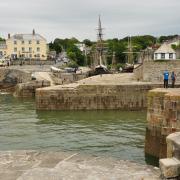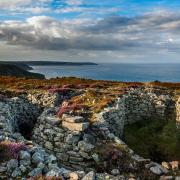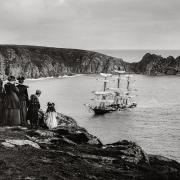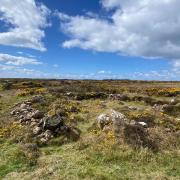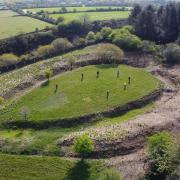Enthusiast Stephen Roberts boards the Bodmin Railway line in search of the many ghost trains that no longer run and the lost stations they no longer stop at.
Cornwall saw its share of branch line closures with that railway enthusiast’s bogeyman, Dr Beeching, playing his customary role.
Quaint little communities lost their station and connection to the world. Sometimes the whole branch closed: Even when a line survived, intermediate stops disappeared. Occasionally, a station has been re-born, with trains once more sidling into its platforms. In most places though, it’s ghost trains you’ll be listening out for.

The Bodmin and Wadebridge Railway opened in 1834 with industrial aspirations, connecting the town of Bodmin with the port of Wadebridge and the quarries up at Wenfordbridge. This was the first steam-powered line in Cornwall, predating the mainline to the capital by a quarter century. Taken over by the London and South Western Railway in 1847, the line would survive into the BR era before being closed to passengers in 1967, with freight continuing until 1978 courtesy of china clay.
The three-platform terminus at Wadebridge featured in a John Betjeman film recital: ‘On Wadebridge Platform what a breath of sea scented the Camel valley!’ The station building survives as today’s Betjeman Centre, whilst the former trackbed is now utilised by the Camel Trail. Bodmin meanwhile became ‘Bodmin North’ in 1949 to distinguish it from Bodmin General and fared less well than its counterpart after closure being completely demolished for a car park.

There were many quaint little stops on the line, including Shooting Range Platform, built c.1880 to serve a firing range and used by troops during the Boer Wars and WW1 with soldiers arriving by train as there was no other access. The platform still exists, albeit much overgrown. Dunmere Halt was opened later, in 1906, along with a few other halts for railmotor service operating between Bodmin North and Wadebridge. The platform, which was once blessed with a Great Western Railway (GWR) pagoda-style shelter, is still in situ and looked well maintained the last time I saw it.
The other Bodmin station, Bodmin General, was the terminus of a GWR branch from Bodmin Road (today’s Bodmin Parkway) on the Cornish Main Line. The branch opened in 1887 and the following year saw a junction made with the older Bodmin and Wadebridge Railway at Boscarne Junction. The branch closed in 1983 following the demise of the final freight traffic on the line but in a happy conclusion the heritage Bodmin & Wenford Railway (BWR) began running trains again between Parkway and General in 1990 with the line to Boscarne Junction also being reopened in 1996. There’s even talk of the railway being extended to a new station at Wadebridge which would see some realignment of the existing Camel Trail.

Just to show that this is not entirely a tale of ‘Ghost Stations’, the poetically-named Colesloggett Halt (Betjeman would have approved) was newly opened on the BWR in 1993 and is handy for Cardinham Woods, a local beauty spot.
There are no fewer than 17 closed stations on the stretch of the Cornish Main Line between Plymouth and Penzance, one of which is Defiance Platform, which would have been the second stop after the Royal Albert Bridge (after Saltash) and like Shooting Range Platform was provided for the military. Opened by the GWR in 1905, the platform served naval personnel travelling to a nearby torpedo and mining training school, based on HMS Defiance, the last wooden line-of-battle ship constructed for the Royal Navy (1858-62), which had become a training ship in 1884 and was moored not far from the platform. The platform was moved in 1907 after which access was via steps from a bridge and was finally closed in 1930.

Another of the closed Cornish Main Line stations is Gwinear Road (1852-1964) which acted as the junction for the Helston Branch from 1887. The branch would close to passengers in 1962 and freight in 1964, which also saw Gwinear Road join the ranks of closed stations. The Helston Branch is another making a comeback as the heritage Helston Railway began operating services again in 2011. It currently runs for 1¼ miles between Prospidnick Halt and Truthall Halt and hopes to get closer to Helston in the future where the goods shed and platform survive, the site now part of an old people’s home.
Truthall Halt (1905-62) was reopened in 2018 whilst Trevarno station was a new build (2011) and terminus at the time, but is today an intermediate request stop.The Lostwithiel and Fowey Railway opened in 1869, connecting the Cornish Main Line (Lostwithiel) with the port of Fowey (in fact, it got as far as Carne Point, just north of Fowey). Industry played its part again with china clay being the line’s mainstay. The line suffered a period of closure (1880-95) but then reopened, its passenger service limping on to 1965. The line does remain open, however, for that china clay traffic. Fowey (1874-1965) was once also the terminus for passenger services on another line, the Cornwall Minerals Railway, that headed across to another junction further south-west on the main line at Par (until 1929), and thence on to Newquay, with goods continuing on this line until 1968.

The loss of passenger traffic on the Fowey-Par line saw Fowey’s two platforms reduced to one. There have been suggestions that the Lostwithiel-Fowey line might reopen in the future although Fowey station itself has been demolished with the site currently used as a car park.
Newquay also benefited from a GWR line that was opened in 1905 to Truro and survived until 1963. The closure of the whole 23¾ mile line resulted in a plethora of closed stations including St Agnes which lay 8.5 miles along the line from Truro, saw its last train in February 1963 and is today surrounded by a light industrial estate.
St Agnes had opened 60 years earlier in 1903 as a one platform station, with a siding into a goods shed. Half a dozen years later, in 1909, the station was bustling when the Royal Cornwall Show was held at St Agnes, although passenger trains were unable to cross here with the station still only having the single platform, but a passenger train could cross with a freight if the latter was tucked into the siding.

The station was transformed in 1936 when the single platform was demolished and replaced by an island platform with two faces, which meant passenger trains could finally pass one another here. A new signal box was provided for the ‘go live’ of the new layout which was in January 1937. A footbridge connected the station approach with the island platform, but this was gone by the 1950s presumably because of a lack of custom with any patrons using a crossing thereafter.
I’m pleased that Cornwall has seen some of its closed lines gaining a new lease of life as it means that this story is not only about the end of the line. In many places though it’s fair to say that if you wander down to the old station you’ll see no trains, but if you listen hard you might just hear the spectral whistle of a ghost train...





